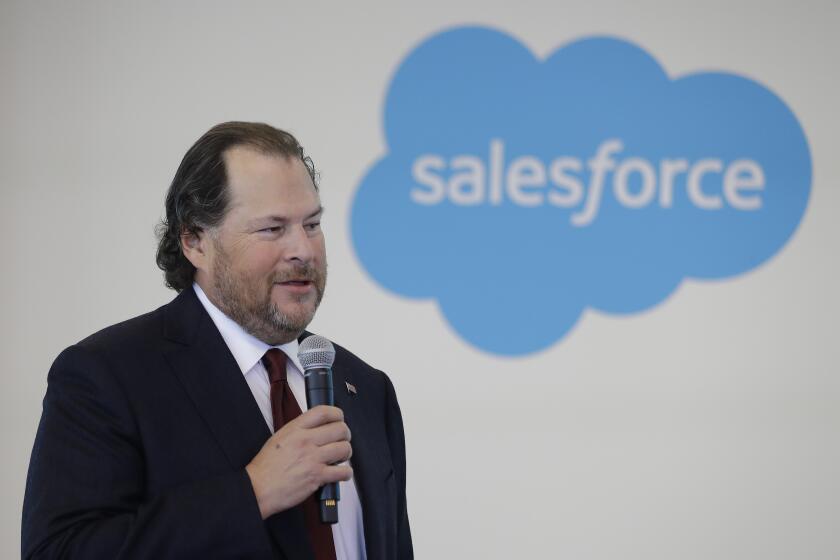High-Speed Web Providers Slow to Meet Needs
- Share via
Things have changed in my life. In the old days, the first thing I would do upon moving into a new place would be to unpack and reconnect the stereo equipment. I might not know where the dishware was, but at least I had my Stan Getz.
Now I have kids and there’s a stereo in my car, so the first thing I did last month on moving into a new home was to unpack and wire up the television and VCR (for them) and the computer (for me).
The second thing I did was call my local @Home office to sign up for its high-speed Internet service because for the first time in my life I’m living in a neighborhood that has broadband.
Unfortunately, I still don’t have broadband.
Now, this isn’t going to be a screed about installation backlogs stretching into the new millennium or about cable installers who don’t keep their appointments. That column may yet come. But I haven’t even got to the point of scheduling a visit.
What I have unearthed is a hitherto unsuspected explanation of why the roll-out of high-speed Internet service, whether it’s through cable modem deals like @Home’s or DSL switching like that available on my block from GTE, has proceeded at the pace of a spavined snail.
The reason appears to be that some of us own too many computers.
“Hello, I’d like to inquire about getting @Home service.”
“I can do that for you, sir.”
“Great. We’ll be connecting two computers.”
“Certainly. All you’ll need is a household network.”
“OK. When will your guys come and install it?”
“Oh, we don’t do that. You’ll have to call a technology company to wire your home.”
Right.
I have one phone line into my house serving three telephones. One dial-up Internet account serving three computers. One TV cable serving three TVs that can simultaneously be tuned to the Bravo channel. (Well, maybe Comedy Central.)
But to have one broadband connection serving two computers, my choices are to rewire the whole house or pay @Home twice.
I’m not alone. The market research firm Dataquest reports that of the 50% of American homes that own PCs, fully a third own two or more. This trend is sure to continue, as parents who once shared a PC with the kids take advantage of the $1,000 price point and buy the kids their own machines. So why should @Home force parents to choose between having its $40-a-month service on Dad’s computer to do his office work or the kids’ computer for their schoolwork?
It’s enough to drive one to DSL. Except that when I called GTE to inquire about their high-speed option--getting my connection over my phone lines--they cited the same one-machine-per-hookup restriction (unless, that is, I installed a home network).
Nevertheless, I did phone the local technology consultants that @Home recommended to install my home network. They explained that they just set up the “hub,” and that I should first call their third-party wiring contractors.
Still going along with the joke, I called those guys, who sent a man over. He surveyed the house, tape-measured the attic and said the rewiring could be accomplished quite easily as long as I didn’t object to a few new holes in the walls and plastic-encased cable snaking down past my third-grader’s bunk bed. Installing the wiring and the hub would cost me at least $500.
That done, @Home would be happy to provide high-bandwidth Web access for the standard $40 a month for the first computer and a mere $6.95 more for the second, which I consider an insult.
One of the more mystifying aspects of this saga is why no one at @Home or GTE mentioned one potentially simple alternative: the home phone line or electrical line networking arrangements marketed by Intel and others--which I’ve noticed are offered as factory-installed options on some computers from Compaq and Gateway.
Apparently these aren’t perfect or bug-free solutions--the best thing I’ve heard about Intel’s AnyPoint system is that “it’s not nearly as hard to install as people say.” But as an alternative to having more contractors traipsing over the premises running up hourly charges, they’ve got to be promising.
I’m sure there are perfectly sound technical reasons for the broadband providers’ reluctance to accommodate multiple-PC users. I’m also sure that any company can find sound technical reasons for not doing something it doesn’t wish to do. I suspectthat the real reasons are bureaucratic and economic.
@Home, which is a hybrid technology-communications company, has a hard enough time coordinating its digital transmission and switching technology with the traditional cable guys responsible for installing the necessary systems in subscribers’ homes. Asking them to handle home network wiring as well might just add to the nightmare. And then there’s the threat to charge an extra $40 a month for a second cable modem. The other day I even heard a tech guru on TV warn listeners that if they networked their homes without notifying their broadband providers first, they might be arrested for “theft of service”.
The chances are probably good that, in time, the broadband providers will realize how counterproductive their policies are. When it was first launched, DirecTV charged full price for every satellite decoder box a subscriber might need for his or her home. Sound technical reasons for that, no doubt. But then the company discovered that the cost of buying, say, three boxes for three TVs was a major obstacle to attracting new customers, and presto: It made the extra boxes available at a steep discount.
Why shouldn’t the high-speed providers similarly bend over backward to attract Web-willing families? Multiple PC users are sure to be their most loyal subscribers and to spend more time online than the average, which, theoretically, should make us prime targets for businesses hoping to snare us in the lucrative e-commerce web.
And we’re easy. Had either @Home or GTE told me that: a) they’d send a crew around to set up my home network at a reasonable installation charge, or b) they’d provide me with a second cable or DSL modem for a discounted additional monthly fee, I’d be a customer today, one more eyeball soldier in their protracted techno-war against each other. But neither did. They offered me costly choices on a some-assembly-may-be-required basis, and I may never get around to taking them up on it.
*
Staff writer Michael Hiltzik is the author of the book “Dealers of Lightning: Xerox PARC and the Dawn of the Computer Age.” He can be reached at michael.hiltzik@latimes.com.





